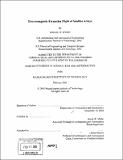| dc.contributor.advisor | David W. Miller. | en_US |
| dc.contributor.author | Kwon, Daniel W., 1980- | en_US |
| dc.contributor.other | Massachusetts Institute of Technology. Dept. of Aeronautics and Astronautics. | en_US |
| dc.date.accessioned | 2006-03-24T18:24:09Z | |
| dc.date.available | 2006-03-24T18:24:09Z | |
| dc.date.copyright | 2005 | en_US |
| dc.date.issued | 2005 | en_US |
| dc.identifier.uri | http://hdl.handle.net/1721.1/30150 | |
| dc.description | Thesis (S.M.)--Massachusetts Institute of Technology, Dept. of Aeronautics and Astronautics, 2005. | en_US |
| dc.description | Includes bibliographical references (p. 167-169). | en_US |
| dc.description.abstract | Proposed methods of actuating spacecraft in sparse aperture arrays use propellant as a reaction mass. For formation flying systems, propellant becomes a critical consumable which can be quickly exhausted while maintaining relative orientation. Furthermore, the total required propellant mass is highly dependant on [delta]V, which requires propellant mass to increase exponentially. Additional problems posed by propellant include optical contamination, plume impingement, thermal emission, and vibration excitation. For those missions where control of relative degrees of freedom is important, we consider using a system of electromagnets, in concert with reaction wheels, to replace the consumables. A system of electromagnets, powered by solar energy, does not rely on consumables such as propellant mass. To fully understand the benefits of using formation flown architectures, we first investigate how the science returns are affected, using NASA's Terrestrial Planet Finder (TPF) as an example. Electromagnets are then implemented on simple multi-spacecraft arrays to understand how the design impacts overall system performance. This model is expanded to include subsystems critical for operation using electromagnets. TPF is then used to benchmark its performance against various micropropulsion systems. Finally the use of electromagnets for multiple roles in space systems is discussed. | en_US |
| dc.description.statementofresponsibility | by Daniel W. Kwon. | en_US |
| dc.format.extent | 169 p. | en_US |
| dc.format.extent | 8163475 bytes | |
| dc.format.extent | 8184280 bytes | |
| dc.format.mimetype | application/pdf | |
| dc.format.mimetype | application/pdf | |
| dc.language.iso | eng | en_US |
| dc.publisher | Massachusetts Institute of Technology | en_US |
| dc.rights | M.I.T. theses are protected by copyright. They may be viewed from this source for any purpose, but reproduction or distribution in any format is prohibited without written permission. See provided URL for inquiries about permission. | en_US |
| dc.rights.uri | http://dspace.mit.edu/handle/1721.1/7582 | |
| dc.subject | Aeronautics and Astronautics. | en_US |
| dc.title | Electromagnetic formation flight of satellite arrays | en_US |
| dc.type | Thesis | en_US |
| dc.description.degree | S.M. | en_US |
| dc.contributor.department | Massachusetts Institute of Technology. Department of Aeronautics and Astronautics | |
| dc.identifier.oclc | 60458866 | en_US |
